HTC Thunderbolt Review: The First Verizon 4G LTE Smartphone
by Brian Klug on April 27, 2011 12:12 AM EST- Posted in
- Smartphones
- HTC
- Verizon
- LTE
- 4G
- Android
- HTC Thunderbolt
- Mobile
- MDM9600
- MSM8655
So remember how the Thunderbolt is pretty thick? It’s because the PCB runs the span of the entire phone and adds thickness. You can see just how much of the board is covered with stuff if you look at the FCC disassembly photo. For comparison, most other smartphones lately use a PCB that runs perhaps half the device height, then packs the battery in beside it.
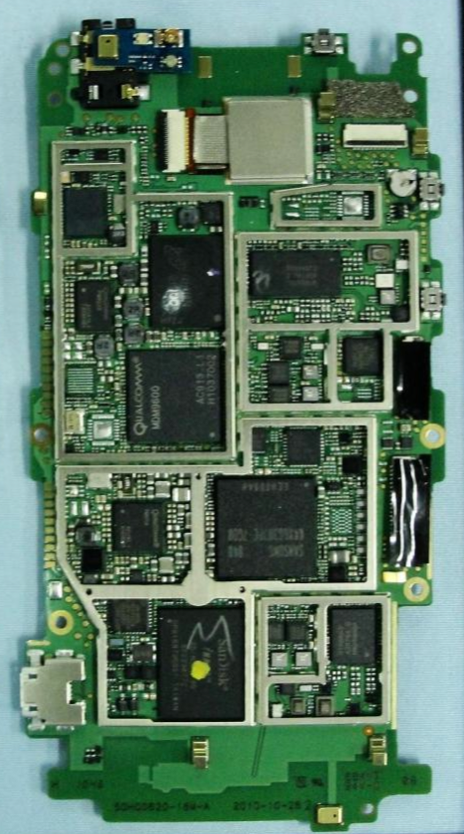
The Thunderbolt's one monolithic PCB - Source: FCC
Whether or not simultaneous voice and data is a deal-making feature is ultimately something philosophical. For me at least, I’ve found that having data sessions pause while I send or receive SMS messages is reason enough for preferring the Thunderbolt over any other CDMA2000 based smartphone to date. The other use scenario that’s compelling is if users want to use an LTE enabled smartphone for tethering.
Thanks to its unique relationship with Qualcomm, HTC will likely have the only simultaneous EVDO/LTE and 1x voice handset for some time. The LG Revolution for example includes MSM8655 and LG’s L2000 LTE-only chipset, the Samsung 4G LTE smartphone (the Droid Charge) uses Hummingbird and probably just an MDM9600 for voice and data, and the Droid Bionic (whatever its status) likely will have a similar single baseband architecture. Recent literature from Verizon suggests that the Droid Charge will be simultaneous voice and data, but only in LTE markets - I strongly suspect this will be how the majority of other first gen LTE phones behave. In addition, voice on the Thunderbolt is not affected at all when transacting data because it’s the same old 1x voice that Verizon always has used. It isn’t VoIP, it’s the same *real* voice connection it always was. I found that voice and data work perfectly at the same time on the Thunderbolt.
4G LTE Thunderbolt Performance Testing
So how does LTE throughput stack up on the Thunderbolt, especially compared to EVDO? A number of other testers noted that speedtest.net shows erroneous upstream speeds thanks to the Thunderbolt’s huge transmit buffer when on 4G LTE.
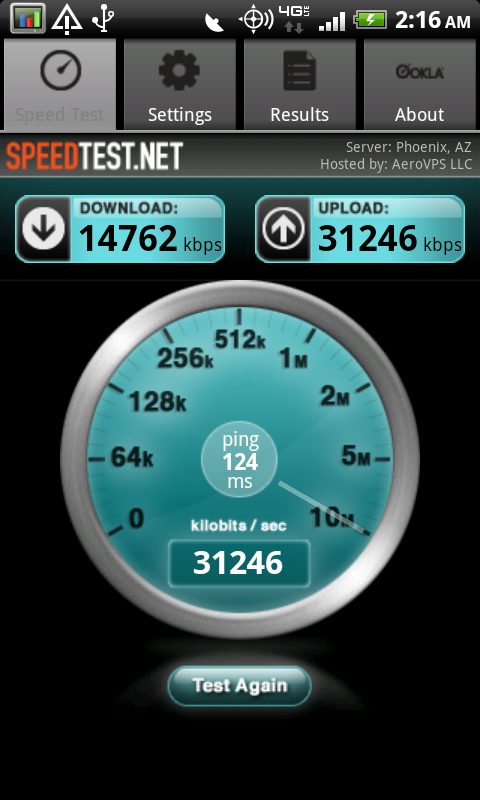
Sorry, there's no way it's uploading at 32.2 Mbps
What happens is that the speedtest.net app’s upstream test size is almost aligned in size with the transmit buffer, so not enough samples are taken to show the realistic speed. Run the test, watch it, and you get a very token bucket looking throughput pattern. What ends up being measured is nonsense for upstream, but nearly valid for downstream. The Android Speedtest.net app has since been updated and shows the proper upstream throughput profile and has a UI that matches the iOS version, but my testing was originally done when the old version was the only option.
All of that isn’t a huge deal however, since we can browse the real web version inside the flash enabled browser. Yay for mobile flash!
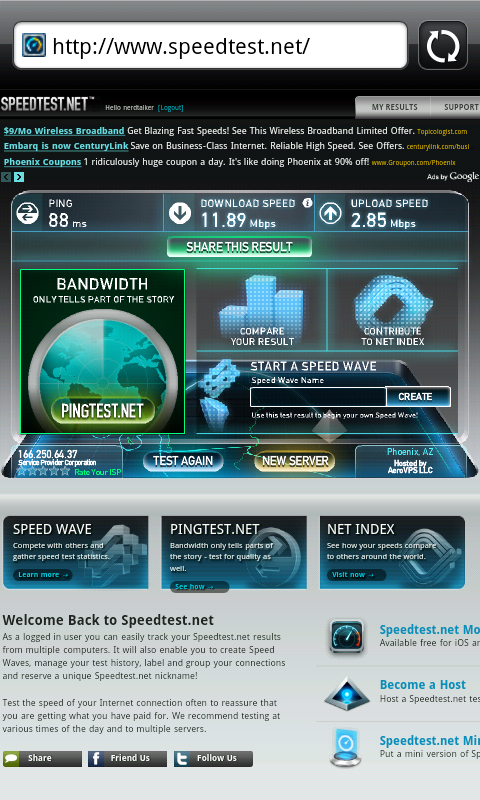
I’ve run a ton of tests on the Thunderbolt in just about every coverage scenario imaginable up in Phoenix, AZ. At interstate speeds on the I-10, 202 loop, downtown central Phoenix, inside every mall (yes, every major mall), indoors, outdoors, good and bad coverage, you name it. There’s even more testing in the LTE piece, but here I’m presenting results just from the Thunderbolt acquired from running the flash version of speedtest.net. All together this is 163 data points collected for the Thunderbolt alone.
First up is downstream. I've collected results for both 4G LTE and 3G EVDO:
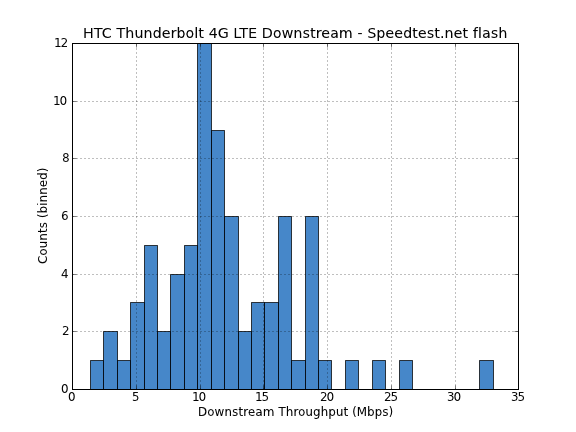
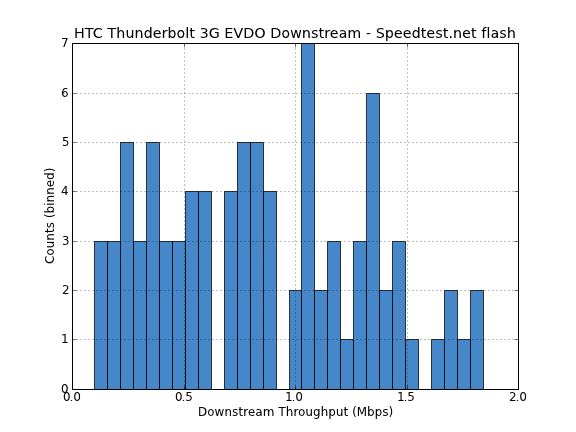
Next up is upstream, again on both 4G LTE and 3G EVDO:
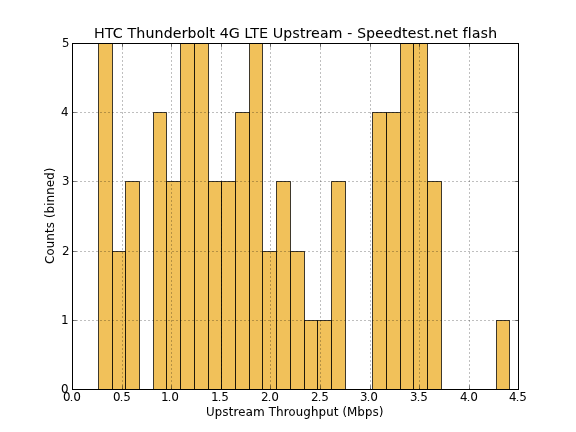
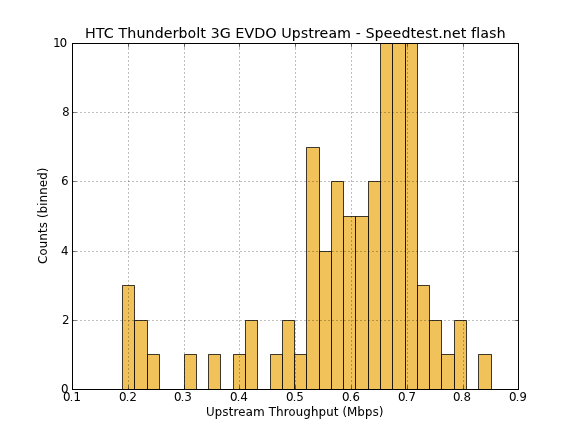
Finally we have latency, again on 4G LTE and 3G EVDO:
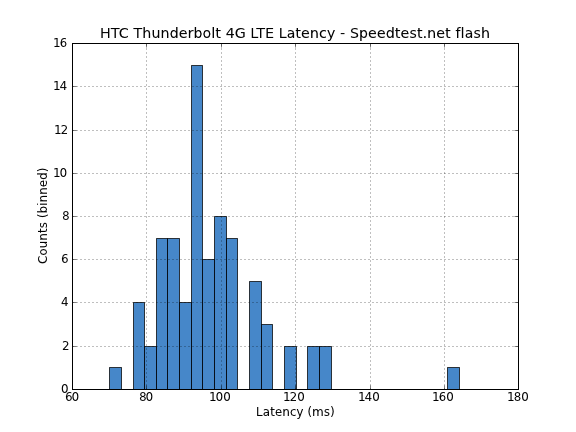
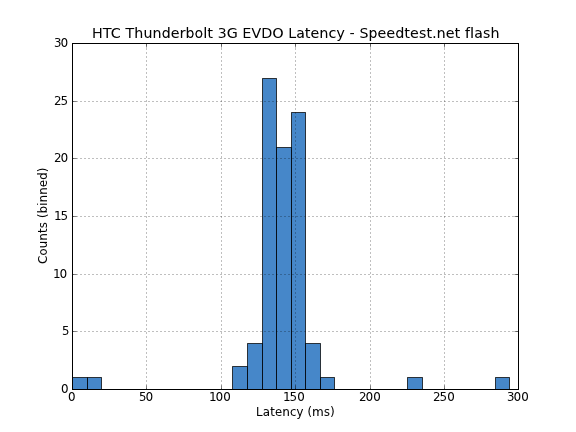
What’s interesting is that upstream speeds on the Thunderbolt are a bit more spread out than for data cards, likely due to the 1 Tx stream (as opposed to two for others). Downstream speeds are impressive, however, clustered primarily around 10 Mbps. Latency is also clustered around 90 ms.
What really speaks to me, however, is that with 4G LTE, worst case speeds are as slow as EVDO is fast. Put another way, LTE’s slowest is about EVDO’s fastest.
Average speeds are about an order of magnitude faster on LTE than EVDO. Latency is down from around 150 ms on EVDO to around 90 ms on LTE.
Coupled with the WiFi hotspot feature, it’s also finally feasible to play games over cellular when on 4G LTE without having insane amounts of latency. While you can arguably survive with some consoles on EVDO or HSPA right now thanks to copious amounts of latency interpolation, nothing really beats actually having sub 100 ms latency. I found that I was able to play CS:S to a nearby server hosted in the same locale and get 70-80 ms of latency tethered over WiFi on the Thunderbolt. By comparison, using a Pantech UML290 (4G LTE datacard) netted me between 50-60 ms. It’s clear that NAT and WiFi overhead add around 20 ms to the connection, but overall the result is a totally usable experience. I've put together a video showing this all in action.
4G LTE implementational details are also important, and I found that the Thunderbolt is close to perfect. The initial handover when you enter an LTE enabled market is a little long. I drove from outside the greater Phoenix metro area into coverage multiple times and timed about 3-5 minutes before hard handover happened. That’s of course if you don’t provoke the handover to happen manually by toggling airplane mode or through *#*#4636#*#* (4636 stands for info) as I’ll show in a minute. When you’re already inside LTE coverage area and simply drop down to 3G, handing back and forth is much faster, it’s nearly instantaneous.
I definitely noticed that Verizon’s 700 MHz spectrum (which is allocated to LTE) does have better propagation characteristics in urban environments that are traditionally very hard to get done right. Large malls and shopping centers specifically are notoriously bad, and the Thunderbolt had no issue clinging to 4G signal in all but the worst areas. In those edge cases, it’ll fall down to EVDO or 1x. I did find that sometimes the LTE to EVDO handover happens a bit more than I’d like it to, if you know you’re in an LTE coverage area, however, you can force LTE only through info.
One of the major complaints and curiosities about the Thunderbolt is that there’s no toggle for 4G LTE in the higher level user menus. If you’re in an LTE market, it makes sense to use it whenever possible, however there are measurable power savings from using EVDO only. In either scenario however the two cellular modems are both powered on. With the Thunderbolt I’m more concerned with keeping LTE always selected and never handing over to anything less. Allow me to introduce you to Phone Information.
There’s an app floating around that gets you here, or you could make a shortcut using anycut, but it’s always been accessible using a dialer code. I simply dial *#*#4636#*#* whenever I want to get here.
Virtually every Android phone has this menu and the same options, unless the carrier has gone to lengths to disable it. The Samsung Fascinate, for example buried this under a ton of obfuscation, and the HTC Inspire 4G disallows selection of anything less than constant HSPA, but I digress.
Tap Phone Information, and now you get access to a lot of status information including signal strength in dBm and asu, some cell location info, network attach status, and the connection type. Here you can see CDMA - eHRPD in EVDO (enhanced High Rate Packet Data), CDMA - 1x or LTE when in appropriate coverage. Tap “set preferred network type” and you can now select between a number of options. LTE mode is unsurprisingly for an LTE-only mode, standard is CDMA + LTE/EVDO auto, EVDO and CDMA only are both self expanatory. Keep in mind that in every mode the MSM8655 modem is still on and maintaining a 1x voice or data connection. I find this menu again more useful for forcing LTE only and avoiding any annoying hard handovers if you’re absolutely certain you are in an LTE coverage area. You don’t need to use it though, everything works fine out of box.


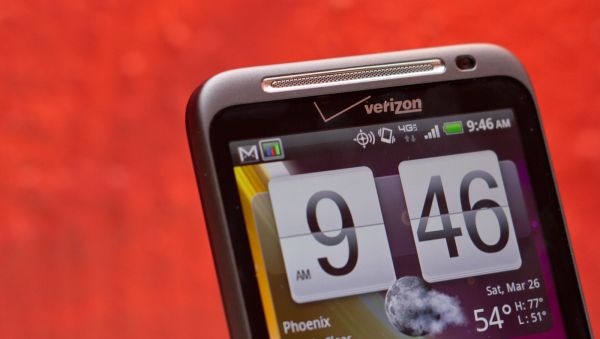
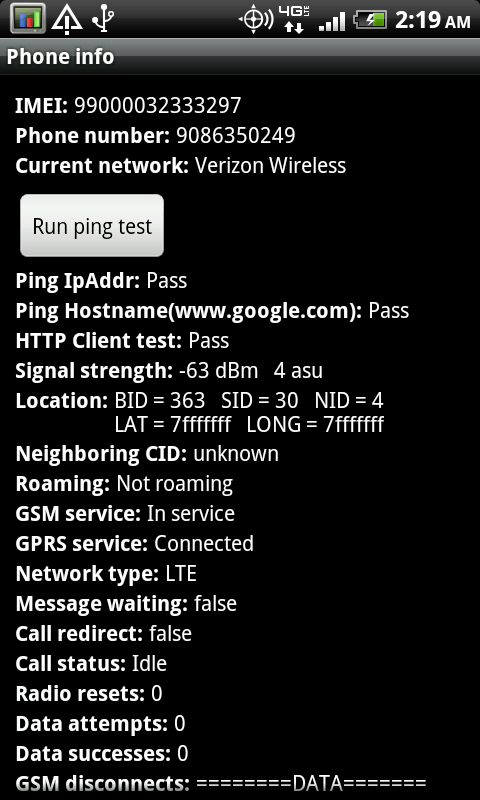
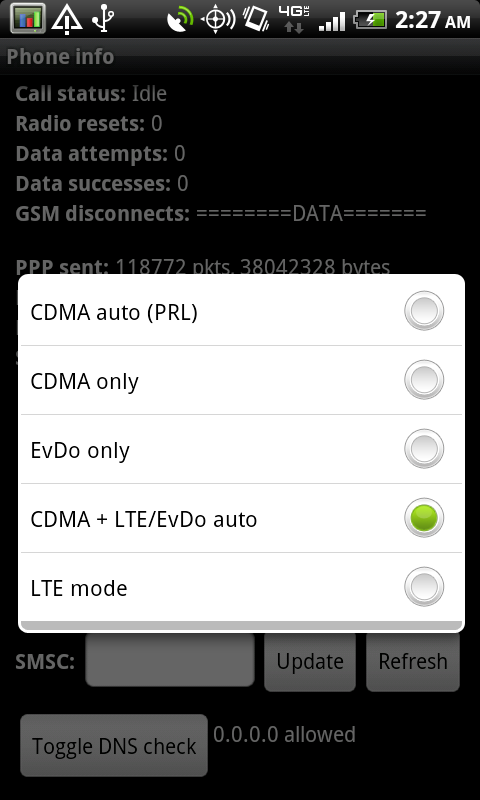








71 Comments
View All Comments
Omid.M - Thursday, April 28, 2011 - link
A friend "in the know" (yeah, yeah) said HTC accidentally shipped it with S-ON for that portion of the internal storage, and that HTC had (has?) issued an OTA that will allow the full 8GB to be useable. Not sure if it's been pushed, as I don't have the Thunderbolt.Brian,
1) How quickly did GPS lock?
I feel like some of these issues that users experience with other phones---e.g. GPS lock on SGS phones---should be considered for reviews of future phones. I know it can be a hassle, but it should highlight that some issues are manufacturer specific. Hopefully, it lights a fire under mfrs. to correct these problems, if they see that other phones don't suffer from the same.
2) Also, maybe I missed it, but has AnandTech established a Light-Moderate-Heavy usage pattern for phones to test battery life?
i.e., Moderate = 45 min of Bluetooth, 20 min GPS navigation, 10 phone calls, 50 sms, 20 still pictures, etc ?
I saw you set display brightness to 50% and loaded web pages, but I'm talking about how a user would normally use the phone: calls, sms, pictures, BT, GPS...etc.
I am positive you guys have done it before.
Really amazing review. Have been spreading the word, hoping more people flock to AnandTech. You guys deserve the recognition!
@moids
Brian Klug - Thursday, April 28, 2011 - link
Moids,I haven't gotten any OTA updates, but that's entirely possible. Sometimes these review units get updates on a different schedule, so I have no idea. I should check whether it's S-ON or S-OFF.
I constantly forget to post about our GPS testing, possibly because I take it for granted these days that devices do it right. It's something I do test however with a bunch of phones at the same time and compare SNR for all the visible satellites using GPS-Test.
GPS locks fast, but not extremely fast. I took multiple road trips to Phoenix with the Thunderbolt doing navigation guidance. I'd say that 15 seconds with complete sky LOS is enough to get a lock. In location services it does have checkboxes for Verizon's location services and google's. I neglected to take screenshots but SNR is very good on the TB, no GPS problems here.
So the battery life test situation is continuing to evolve. We're working on and will have a system trace setup (exactly what you mention, GPS, using the phone, SMS, browsing) eventually. It's still in progress, of course it'd only work for Android comparisons at present.
Thanks for the good word as always ;)
-Brian
Omid.M - Thursday, April 28, 2011 - link
Feature requests:1) permalinking
2) Signature (with char. limit, like 40 chars, for Twitter ID,etc.)
3) Comment reply notification -- this one is HUGE. It's impossible for me to find replies to my comments, given then I can reply to an old comment (so my reply is "newer") but still buried in a sea of comments from older dates. Make sense?
4) Add Tapatalk compatibility to the AT forums. The mods said they're just waiting on Anand to approve, and I've given examples of other forums built on the same system (phpBB, etc) with equal or more users, to show that those forums are working fine and won't buckle under high traffic. Just have to register the forums (free) with Tapatalk so we can post using the Android/iOS app.
Oh, and a Wordpress style mobile version of these articles would be sweet, especially for commenting.
Come on, AT! The best tech site on the net should have these features! :D
Great work as always. Hope you nail those papers, Brian.
Omid.M - Thursday, April 28, 2011 - link
Awesome. Thanks for the reply!The OTA is coming if it hasn't already. I'll check with my source, but he said HTC definitely wanted to make the full 8 GB usable, so it was definitely a minor oversight on their part which they intend to correct.
I don't know why more manufacturers haven't built antennas into the cover. It definitely seems the way to go.
FYI,
Regarding the sig, if you could make it so the badge (to the left) has another bar below the handle where you can put, say, a Twitter ID...well, that'd be slick...hint hint.
That way, since it can only take something like a Twitter ID, you won't have to worry about junk URLs clogging up the comments section. Plus, people can retweet or tweet at individual comments.
Expect more RTs of this article shortly :)
whthawk - Friday, April 29, 2011 - link
Fascinating and easy read. Thanks!FITCamaro - Sunday, May 1, 2011 - link
I love all the people who are like "its thick and heavy....waaaa..." Man up people. Some of us like to have a phone that has some meat to it so we don't feel like we're going to break it. Nor is 5 ounces instead of 4 going to make any difference. For me even the Thunderbolt barely is noticeable when I'm holding it.floyd1 - Wednesday, May 4, 2011 - link
he folks who can tell me how can i order this htc thunderbolt???? and what is the price??? hope some one can help me my regards floyd from hollandname99 - Saturday, May 7, 2011 - link
"The Thunderbolt has noticeably less attenuation when held in a 4G LTE scenario, no doubt thanks in part to the fact that it's fully leveraging MIMO "This statement makes no sense.
(a) To know what is going on requires knowing what is being reported by that signal strength number. THE big issue with mobile radio is the VARIANCE in signal strength. This variance occurs on a timescale of 10s of ms, and a spatial scale of cm/
So when that dB number is reported, what EXACTLY is being reported? The maximum value over the past n seconds? The minimum value? A time average of the power, converted into dB? A time average of the dB rating. (Since the mapping from power to dB is non-linear, these two types of averages are VERY different),
(b) MIMO is NOT a technology to deal with a weak radio signal, in fact the exact opposite.
Given two antennas, you can use them in two DIFFERENT ways.
(i) You can use the two antennas via receive diversity, which means they each pick up an independent version of what is essentially the same signal. This is useful when the amount of signal variance means that one of the signals is frequently too weak to be useful, but usually not both, so at least one of the signals is strong enough to be useful.
ST codes like Alamouti are a fancy version of this idea.
Note --- this is useful for situation where the combination of the mean signal strength AND the variance means that the signal is sometimes too weak. It does not help if the mean strength is too low to be useful; it is a coping mechanism for a high variance.
(ii) MIMO is different. MIMO says we will use the two antennas to decode what are essentially two independent streams of data, and double our throughput. For this to work, we require that the lowest signal strength received (even in the presence of variance) not be too low. Thus this is a technology to take advantage of either a high mean signal strength, or an unusually low variance in the signal strength.
You can use your antennas to give you either diversity (more consistent reception) or MIMO (higher throughput, under good conditions), but not both.
NEITHER diversity nor MIMO can deal with a signal that is too weak. There IS multi-antenna technology that can do this (beam shaping) but I don't know if any carrier or cell-phones use this.
In other words, if this phone shows lower attenuation when being held
(a) who knows WTF that actually means, since we have no idea what is actually being measured
(b) it likely has more to do with the details of the placement and geometry of the antenna than with antenna diversity
(c) it certainly has nothing to do with the specific technology of MIMO
name99 - Saturday, May 7, 2011 - link
Having made the complaint above, congrats to Brian for taking my earlier complaints about these reviews to heart and trying to get a more comprehensive picture of the capabilities of these phones beyond mere headline numbers!Certainly, for example, the histograms are very helpful.
EvoGuy - Monday, May 16, 2011 - link
Droid Charge does not have an MDM9600 or any other Qualcomm IC.Of the four LTE smartphones coming to Verizon, only HTC has a Qualcomm LTE IC. CDMA is handled by VIA in the Charge, Q has the other three.
Also, EV-DO stands for EVolution-Data Only. "Data Optimized" is a backronym to try and cover up the fact that EV-DO cannot support voice. There was a standard called EV-DV (EVolution - Data & Voice), but it was killed by the giant IC company.